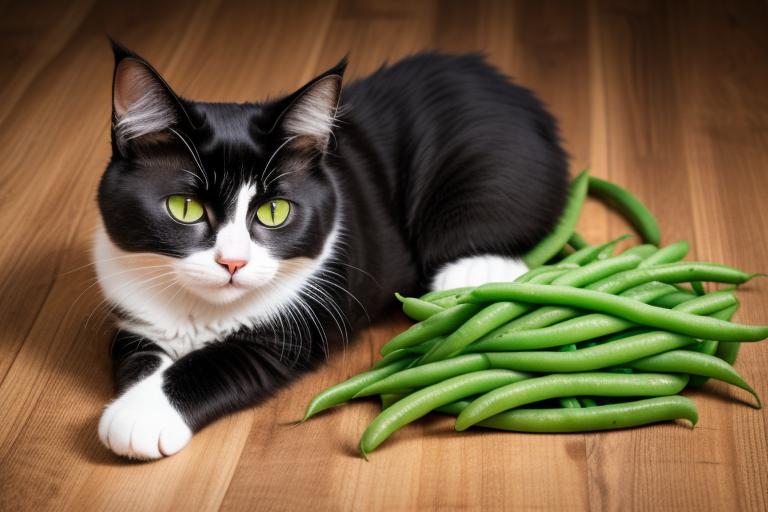Have you ever wondered if cats can indulge in the humble green bean? Well, it’s time to unravel the mystery and shed light on whether your feline friend can savor this crunchy vegetable.
Green beans, symbolizing a wholesome and nutritious addition to any plate, may seem like a suitable option for your cat’s diet. But before you start serving them a bowlful, there are a few things you need to know.
So, let’s explore the world of cats and green beans together, and discover if it’s a safe and beneficial choice for your furry companion.
Nutritional Value of Green Beans for Cats
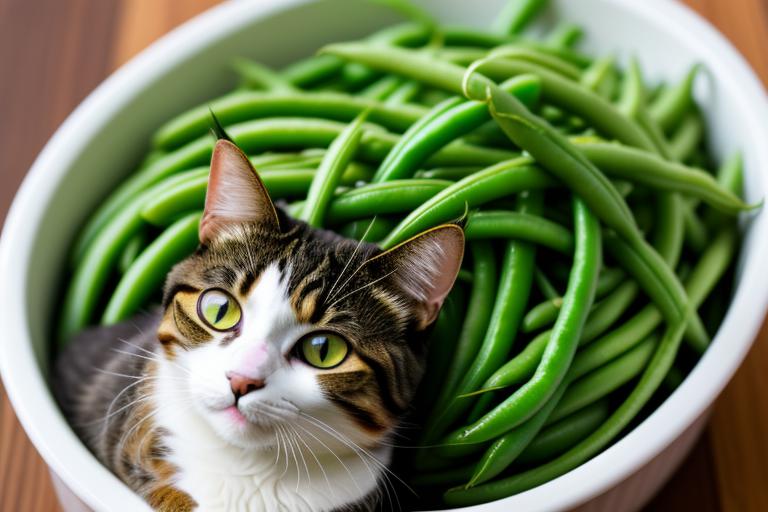
What nutritional benefits do green beans offer for cats?
Green beans can actually be a healthy addition to your cat’s diet. They’re low in calories and fat, making them a great option for cats who need to lose weight or maintain a healthy weight. Green beans are also a good source of dietary fiber, which can help regulate your cat’s digestion and prevent constipation. Additionally, they contain essential vitamins and minerals, such as vitamin A, vitamin C, and potassium, which are important for your cat’s overall health and well-being.
However, it’s important to note that green beans should only be given to cats in moderation. While they offer several benefits, they shouldn’t replace a balanced cat food diet. A good rule of thumb is to offer green beans as a treat or supplement to your cat’s regular meals. Start by introducing small amounts and monitor your cat’s reaction. If your cat enjoys green beans and shows no signs of digestive upset, you can gradually increase the amount. Remember to consult with your veterinarian before making any significant changes to your cat’s diet.
Potential Benefits of Green Beans in a Cat’s Diet
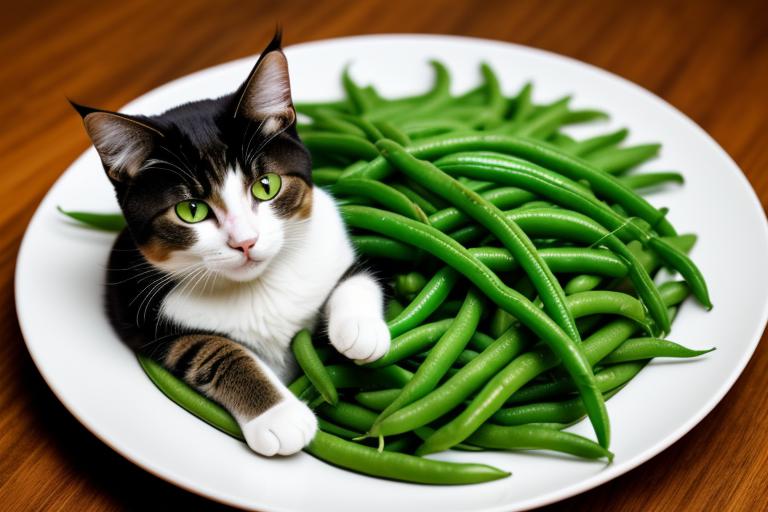
Green beans can provide a range of potential benefits for your cat’s diet. Apart from being a low-calorie and low-fat food option, green beans offer various health benefits for your feline friend. One of the key advantages is their positive impact on digestive health. Green beans are rich in dietary fiber, which aids in regulating your cat’s bowel movements and promoting healthy digestion.
The high fiber content in green beans can help prevent constipation in cats. It adds bulk to their stool, making it easier for them to pass waste. Additionally, green beans can help regulate your cat’s appetite, as the fiber helps them feel full and satisfied for longer periods.
Moreover, the fiber in green beans can also contribute to weight management in cats. By incorporating green beans into your cat’s diet, you can help them maintain a healthy weight or even shed some pounds if necessary.
To introduce green beans into your cat’s diet, start by steaming or boiling them until they’re soft and easily chewable. Allow the beans to cool before offering them to your cat. Remember to consult your veterinarian before making any significant changes to your cat’s diet to ensure it’s suitable for their specific needs.
Risks and Considerations of Feeding Green Beans to Cats
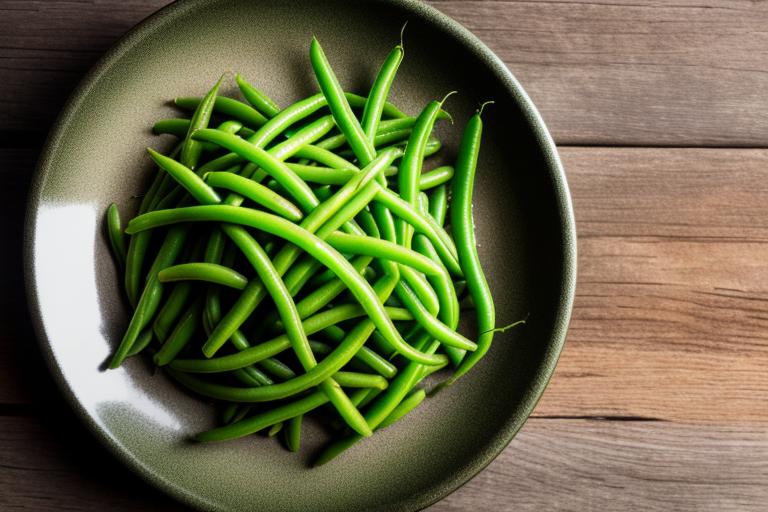
Feeding green beans to your cat may pose certain risks and considerations that you should be aware of. While green beans are generally safe for cats to consume, there are potential health risks and digestive issues that may arise.
One of the potential health risks is the presence of pesticides or other chemicals on the green beans. It’s important to thoroughly wash the beans before feeding them to your cat to minimize the risk of ingesting harmful substances. Additionally, some cats may have allergic reactions to green beans, resulting in symptoms such as vomiting, diarrhea, or skin irritations. If your cat shows any signs of discomfort or allergic reactions, it’s best to discontinue feeding them green beans.
Another consideration is the impact on your cat’s digestive system. Green beans are high in fiber, which can be beneficial for cats with constipation issues. However, too much fiber in their diet can lead to digestive issues such as bloating, gas, or diarrhea. It’s important to introduce green beans gradually into your cat’s diet and monitor their response. If you notice any digestive issues, it may be necessary to reduce or eliminate green beans from their diet.
How to Introduce Green Beans to Your Cat’s Diet
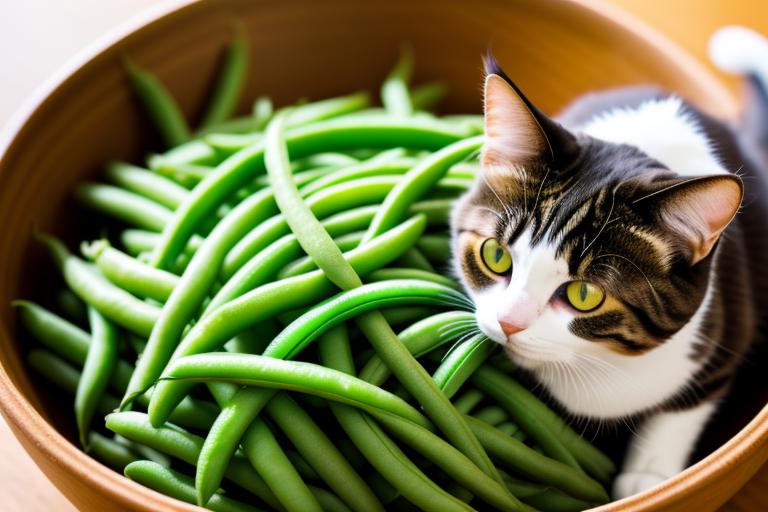
To successfully incorporate green beans into your cat’s diet, gradually introduce them while monitoring their response. Introducing new foods to your cat’s diet should always be done slowly and in small amounts. Start by offering a few cooked green beans as a treat or mixed with their regular food. Observe how your cat reacts to the new addition. Some cats may immediately take to the taste and texture of green beans, while others may be more hesitant.
It’s important to note that not all cats will have a preference for green beans. Each cat is unique, and their taste preferences can vary greatly. If your cat shows no interest in green beans, don’t force them to eat it. There are plenty of other healthy foods you can offer as an alternative.
If your cat does enjoy green beans, you can gradually increase the amount you offer over time. However, it’s crucial to monitor their response and watch for any signs of digestive upset or allergies. If you notice any adverse reactions, it’s best to discontinue feeding green beans and consult with your veterinarian.
Other Safe and Healthy Vegetables for Cats
If your cat isn’t a fan of green beans, there are still plenty of other safe and healthy vegetables you can introduce into their diet. Cats, just like humans, need a balanced diet to thrive and stay healthy. While a complete and balanced cat food is essential, adding some vegetables can provide additional nutrients and variety to their meals.
Here are some alternative vegetable options for picky cats:
- Carrots: Carrots are low in calories and high in fiber, making them a great option for cats. They’re also a good source of vitamin A, which is important for maintaining good vision and a healthy immune system.
- Peas: Peas are packed with vitamins and minerals, including vitamin K, vitamin C, and manganese. They’re also a good source of fiber, which can help with digestion and prevent constipation.
- Broccoli: Broccoli is a nutrient powerhouse for cats. It contains vitamins A, C, and K, as well as fiber and antioxidants. However, make sure to cook it before serving, as raw broccoli can be difficult for cats to digest.
Frequently Asked Questions
Feeding your cat green beans every day can be beneficial. Green beans provide fiber, vitamins, and minerals that can support their digestive health. However, it’s important to consult with a veterinarian to ensure it fits your cat’s specific dietary needs.
Canned green beans are safe for cats to eat. They can help with weight loss in cats and provide dental health benefits. Just make sure to serve them in moderation as a supplement to a balanced diet.
Green beans are generally safe for cats to eat and can provide benefits to their urinary tract health. However, excessive consumption may cause digestive issues. They can also aid in weight management for cats.
Cooking methods can affect the nutritional benefits of green beans for cats. While some cats may enjoy raw green beans, cooking them can make the nutrients more accessible and easier to digest.
Potential health benefits of green beans for cats include vitamins and fiber. However, some cats may have allergies or sensitivities. If this is the case, consider alternative veggies like cooked carrots or peas.
Conclusion
In conclusion, green beans can be a safe and healthy addition to a cat’s diet. They provide nutritional value and potential benefits such as weight management and improved digestion.
However, it’s important to introduce green beans gradually and monitor your cat’s response. Consult with your veterinarian for guidance and consider other safe vegetables like carrots or peas to vary your cat’s diet.
Remember, always prioritize your cat’s health and well-being when making dietary choices.

